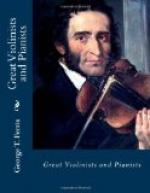master.... It is most easy to speak of his outward
appearance. People have often tried to picture
this by comparing Liszt’s head to Schiller’s
or Napoleon’s; and the comparison so far holds
good, in that extraordinary men possess certain traits
in common, such as an expression of energy and strength
of will in the eyes and mouth. He has some resemblance
to the portraits of Napoleon as a young general, pale,
thin, with a remarkable profile, the whole significance
of his appearance culminating in his head. While
listening to Liszt’s playing, I have often almost
imagined myself as listening to one I heard long before.
But this art is scarcely to be described. It
is not this or that style of piano-forte playing; it
is rather the outward expression of a daring character,
to whom Fate has given as instruments of victory and
command, not the dangerous weapon of war, but the
peaceful ones of art. No matter how many and great
artists we possess or have seen pass before us of
recent years, though some of them equal him in single
points, all must yield to him in energy and boldness.
People have been very fond of placing Thalberg in the
lists beside him, and then drawing comparisons.
But it is only necessary to look at both heads to
come to a conclusion. I remember the remark of
a Viennese designer who said, not inaptly, that his
countryman’s head resembled that of a handsome
countess with a man’s nose, while of Liszt he
observed that he might sit to every painter for a Grecian
god. There is a similar difference in their art.
Chopin stands nearer to Liszt as a player, for at
least he loses nothing beside him in fairy-like grace
and tenderness; next to him Paganini, and, among women,
Mme. Malibran; from these Liszt himself says
he has learned the most.... Liszt’s most
genial performance was yet to come, Weber’s
‘Concert-stuck,’ which he played at the
second performance. Virtuoso and public seemed
to be in the freshest mood possible on that evening,
and the enthusiasm during and after his playing almost
exceeded anything hitherto known here. Although
Liszt grasped the piece from the begin-ing with such
force and grandeur that an attack on the battle-field
seemed to be in question, yet he carried this on with
continually increasing power, until the passage where
the player seems to stand at the summit of the orchestra,
leading it forward in triumph. Here, indeed,
he resembled that great commander to whom he has been
compared, and the tempestuous applause that greeted
him was not unlike an adoring ‘Vive l’Empereur.’”
Flattering to his pride, however, as were the universal honors bestowed on the artist, none were so grateful as those from his own countrymen. The philanthropy of his conduct had made a deep impression on the Hungarians. Two cities, Pesth and Odenburg, created him an honorary citizen; a patent of nobility was solicited for him by the comitat of Odenburg; and the “sword of honor,” according to Hungarian custom, was presented to him with due solemnities. A brief account from an Hungarian journal of the time is of interest.




